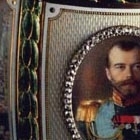Here's a great article with an actual catalog from the Schaffers - before ALVR was opened - offering Faberge and Imperial treasures for sale in New York

 Our Lady of the Sign Church In 1717 the building of a wooden church in honour of the Annunciation was begun (probably by the same architect Foerster). It had a stone foundation and stood on the spot of the present Znamenskaya palace church. The walls were plastered on the inside, and on the outside were covered with painted boards to represent stone stucco; the cupola and the top of the belfry were covered with white iron; the crosses were gilded. On Sunday on the 9th of Aug. 1724, the church was consecrated in the presence of Peter-the-Great and Catherine. The Emperor and Empress had already on the 7th of August moved to Tsarskoe Selo; while on the 8th arrived the ministers and the persons of distinction; on the 9th the church was consecrated. After the mass thirteen cannon volleys were fired, and all the ministers and men of rank from the Synod, the archbishops George Dashkov of Yaroslav, Feofan Prokopovich of Pskov and Alexis Titov of Viatka, ate their meals in tents, and remained there till midnight, all the time the cannon firing. Towards evening on the 10th Peter and Catherine returned to the capital.After this ceremony, Tsarskoe Selo was being called for a time the "Annunciation Village" but in two months it had back its old name. On the 24th of June 1728, this church struck by lightning was burnt to the ground, but the Holy Vessels, and the damask iconostasis from the chapel were saved. In 1734 the Tsarevna Elizabeth, began to build a stone church to the "Miraculous Apparition of the Virgin" on the spot of the Annunciation church, which was burnt. An Imperial order was given to build two chapels at the sides of the main church, in memory of St. Catherine the Martyr, and of the Holy and Orthodox Zachariah and Elizabeth; a third chapel was to be over the porch, and immediately under the bell tower, another chapel to Nicholas the Miracleworker. It took a very long time to build this church. On the 8th of May 1746 the two side chapels were consecrated and only in May of the next year the whole church was finished. The chapel, under the bell tower, was apparently consecrated during the reign of the Empress Anna Ioannovna, since there is an article in the journal of the Harbinger of the Chamber, dated Jan. 20th 1742, which says, that the Empress Elizabeth Petrovna was pleased to attend the christening as godmother of three Persians and two Turks in the stone church of the Miraculous Apparition of the holy Virgin Mary. During the next years there are frequent paragraphs, which mention the presence of the Empress either at Mass or vespers in the church of Nicholas-the-Miracle worker. Here in 1758 the Empress Elizabeth had her first attack of apoplexy. The empress Catherine II in her memoirs gives the following description of this episode: "The Empress was at the beginning of September in Tsarskoe Selo, and there,on the 8th, on the day of the Nativity of the Virgin, she went on foot from the palace to the parish church, (which is but two steps from the North Gate), to hear the mass. Hardly had the service begun, when the Empress, feeling unwell, left the church, went-down the steps and, on reaching the corner of the church, fell unconscious on the grass, amid, or rather surrounded, by a crowd of people, who had come from all the surrounding villages to hear Mass. No one from the Empress' suite had followed her, when she left the church, but soon her ladies, being warned, ran to give her help; they found her motionless and un conscious, in the midst of the crowd, who stared at her, but dared not go near. The Empress was very tall and corpulent, and could not fall without hurting herself badly. They covered her with a 'white cloth and sent for the doctors and the surgeon; the latter came first and found it necessary to bleed her on the spot; but she did not come round. The doctor was a long time coming, for he was ill himself and could not walk, so they had to bring him in an armchair. This was the late Kondoidi, a Greek by birth; the surgeon was named Fuzade, a French emigrant. At last screens and a sofa were brought from the palace. The Empress was placed on the sofa and, after medicine had been administered, consciousness returned slightly. But when she opened her eyes, she did not recognize anyone and asked in an almost inarticulate voice, where she was? All this had taken more than two hours. It was then decided to carry Her Imperial Majesty on the sofa to the palace. One can imagine the dejection of the Court. The publicity of the event only added to the sorrow, for up to this time the illness of the Empress had been kept secret, and from that moment the event became public". At the present time the church has only one chapel of the Miraculous Apparition of the Virgin. The two side chapels were pulled down in 1891, on the spot of the left chapel stands an ikon of "Our Lady of Kazan", while on the right side, at the entrance of a small vestry, stands a miracle working icon. Behind the icon, with an outlet to the Church, is a small room for the use of the members of the Imperial family. The iconostasis from the two side chapels were sent to the Rekonsky Monastery in the government of Novgorod; at the same time the church was thoroughly restored, the room for the members of the Imperial family was built, with a separate entrance, and the church was considerably widened near the main entrance. The restoration was carried out by the architect Danini. The church consists of a central and two side aisles; the walls above the panels are of dark red artificial marble; the lower parts of the arches are covered with the same material; while the iconostasis is white with gilding in the style of the renaissance. Two gilded sculptured angels over the central part of the iconostasis support the Imperial crown. The lustre, in fine Empire style, was given anonymously in 1865. During the reign of Catherine II, the court visited the church less often, than it had done under Elizabeth, and the church began to be considered as a parish church. But Catherine invariably heard mass there on the parish saint's days. In her time too, solemn thanksgiving for victories took place here, and manifestos were read. The Emperor Alexander I and his Autocratic Successors always showed special veneration for the church, with the ancient hereditary icon of the House of Romanoff, the image of the Miraculous Apparition of the Blessed Virgin, the most remarkable of all the relics of Tsarskoe Selo. The ikon is painted on wood and is a half figure, representing the Virgin, Her hands raised towards heaven, and the Holy Child, sitting on Her knees without any support. With Her right hand, She gives blessing, while in her left hand she holds a roll of papers. The faces of the Virgin and of the Child are remarkable for their unusual clearness and the brightness of their colouring. The icon is 50 inches long and 36 inches wide. The apostles Peter and Paul, the blessed Zachariah and Elizabeth, and St. Alexis, the Man of God were painted by the wish of the Empress Elizabeth Petrovna; St. Nicholas, and the Holy Martyr, Tsaritsa Alexandra were added in 1859. This relic has been known in Russia ever since the time of the Tsar Alexis Michaelovich, who received it as a gift from one of the Eastern patriarchs. The Emperor Peter I had a special veneration for the ikon, and had it brought to his palace in St. Petersburg from Moscow. The popular legend says, that Peter, when dying blessed his daughter Elizabeth with the icon, and that ever afterwards held it in special reverence. She prayed before it on the night, when the revolution, which put her on the throne, took place. Immediately after her accession, Elizabeth Petrovna had a golden covering, forged out of all her jewels, weighing 27 1/2 lb of pure gold, made for this ikon. When the construction of the church of the Miraculous Apparition was finished in 1747, the ikon was brought in a solemn procession from St. Petersburg. The procession with banners and crosses took three days to reach Tsarskoe Selo; the Empress herself took part in it and even carried the icon occasionally. The icon was placed over the Royal Gate, but on the 5th of July 1831, after a service during the cholera, which threatened the town, it was removed, to the right alter. Since that year, on the 5th of July the image is always being carried round the town, and a solemn Te Deum is sung on the square before the Great Palace. In 1848 the daughter of a tradesman of Tsarskoe Selo, Maria Davidov, had a vision in her sleep, and covered with richly, embroidered vestments, the holy icon. Offerings for the work were made very liberally by the inhabitants of the town; the best of the diamonds and other precious stones were given by the Empress Alexandra Feodorovna, the wife of the Emperor Nicholas Pavlovich, and by the other members of the Imperial family. The vestments, as well as the rich altar-cloth and carpet, were embroidered by Miss Davidov and by the other ladies of Tsarskoe Selo in 1848. There is a legend, which says, that during the fire, that took place in the Great Palace on, the 2nd of May 1820, when the flames had reached the Lyceum and were spreading towards the central part of the palace, the Emperor Alexander I saw the icon being carried out of the church of the Miraculous Apparition, and exclaimed, "Holy Virgin, save my house". At the very moment the wind changed, and the fire was quickly extinguished. During the fire in the Great Palace, which occurred on the 16th of June 1863, the image was again carried round the palace. As soon as it reached the square in front of the palace, where the Emperor and the Imperial family kissed it, the flames, which had withstood all the efforts of the firemen, were immediately put out. |









